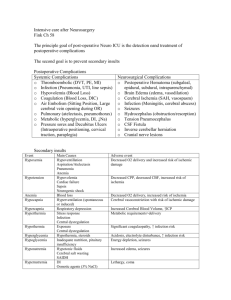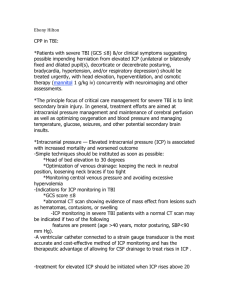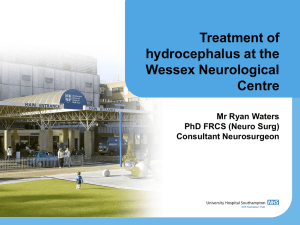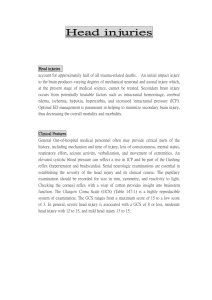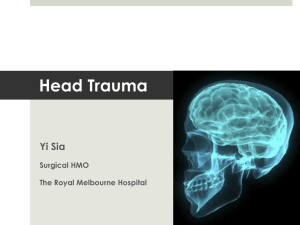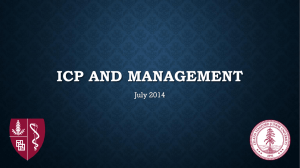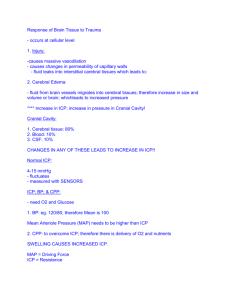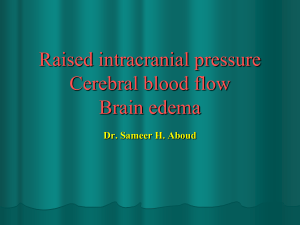educational activities and responsibilities
advertisement
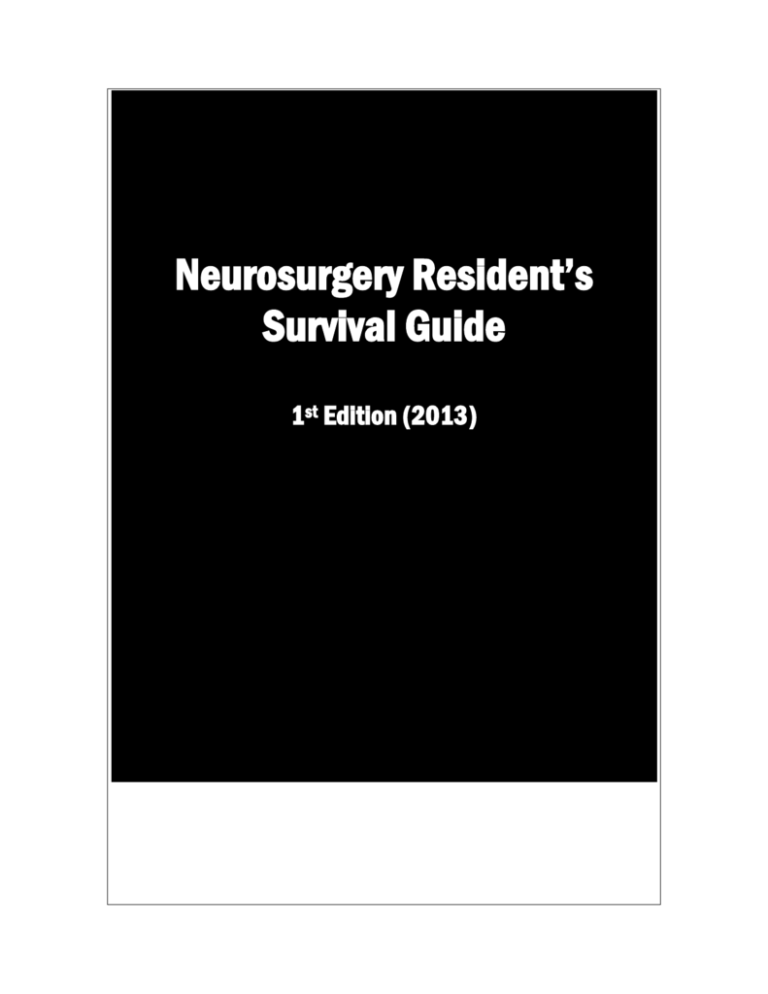
Neurosurgery Resident’s Survival Guide 1st Edition (2013) Neurosurgery Resident’s Survival Guide The Division of Neurosurgery The Ottawa Hospital Copyright: August 2013 (1st Edition) Authors: Saad Alqahatani Diana Ghinda Hubert Lee Table of Contents INTRODUCTION ................................................................................................. 3 OBJECTIVES............................................................... Error! Bookmark not defined. EDUCATIONAL ACTIVITIES AND RESPONSIBILITIES ........................................... 3 ROUNDS FOR RESIDENTS ROTATING TO NEUROSURGERY....................................... 4 CALLS ..................................................................................................................... 4 RESPONSIBILITIES............................................................Error! Bookmark not defined. TECHNICAL SKILLS .......................................................................................... 10 EVD PLACEMENT ................................................................................................... 25 BASIC PATHOPHYSIOLOGIC PRINCIPLES...........................Error! Bookmark not defined. Mass effect and cerebral herniations: ............................... Error! Bookmark not defined. 1.6.2 Hydrocephalus/shunt malfunction and EVD management .... Error! Bookmark not defined. 7. COMMON PATHWAYS ............................................ Error! Bookmark not defined. References ................................................................. Error! Bookmark not defined. Intro Service Description Neurological Exam Neurosciences / Management (ICP, Shunts, Tumour, Hemorrhage, Spine) Technical Issues / Drains Orders / Common medications INTRODUCTION Welcome to your neurosurgery rotation! This is a busy service with a typical census of 40-50 patients. The work can be overwhelming at times, but there are always other residents and staff available to help you and the nurse practitioners are very helpful for the floor issues. EDUCATIONAL ACTIVITIES AND RESPONSIBILITIES The senior residents direct the day-to-day running of the service on a team basis, which begins in the Neurosciences Acute Care Unit (NACU) every morning. Rounds proceed from NACU to the ICU, PACU, and lastly the emergency department for overnight admissions after which the teams divide to complete D7/F7 rounds. The call schedule in addition to the weekly schedules (distributed latest the weekend before) are established by the chief resident indicating your daily assignment to OR or clinic if you are not on call. ROUNDS Residents from other Divisions are always free to attend their specific seminars or other formal educational programs connected with their specialty. Conversely, you are also welcome and encouraged to participate in our weekly rounds which include: Tuesday: 4-6pm (Difficult Case Rounds / M & M’s – D7 Conference Rm) Wednesday: 7:30-8:30am (Neuroradiology Rounds – C2 Conference Rm) Thursday: 4-6pm (Academic Half Day – Didactic Teaching – D7 Conference Rm) Friday: 7-8am (Spine Rounds – C2 Conference Rm), 8-10am (Neurosciences Rounds) CALLS During call you are expected to manage consults at the Ottawa Civic Hospital ONLY from the emergency department, other services, and C2 clinic (clinic admissions). During the day, the nurse practictioners will be available to help field a majority of the floor issues within their range of practice. Any outside calls should be deferred to the staff on call (including the Ottawa General Hospital). THE NEUROLOGICAL EXAM Consciousness * May be confounded with sedation Alertness, Orientation (person, place, time) Mediated from the central pons and hypothalamus with neural tracts projecting signals to relay nuclei in the thalamus up to the cortex, feed back from the cortex to the thalamic nuclei promote arousal Glasgow Coma Score (GCS) o Best verbal response 1. No response (Patients that are intubated give a T (counted as 1)) 2. Incomprehensible sounds 3. Inappropriate words 4. Disoriented and converses 5. Fully oriented and converses o Best eye response 1. Does not open eyes 2. Opens eyes to painful stimuli 3. Opens eyes to verbal command 4. Opens eyes spontaneously o Best motor response 1. No motor response 2. Extension (decerebrate posturing) 3. Flexion (decorticate posturing) 4. Withdraws purposefully from painful stimuli 5. Localizes painful stimuli 6. Follows verbal commands o Range: 3 – 15 (NO GSC 0!), specify the components (e.g. E4V5M6 = GCS 15) o (GSC 13 – mild brain injury; GSC 9-12 – moderate injury; GSC 8 – severe brain injury) Cranial Nerves Midbrain o CN II/III – pupillary light reflex, visual fields Midbrain-Pons o CN III/IV/VI – extra-occular eye movements Pons o CN V/VII – corneal blink reflex, facial sensation, facial movements o CN VIII - occulo-cephalic reflex Medulla o CN IX/X – gag/cough reflex o CN XI – sternocleidomastoid and cervical trapezius m.’s o CN XII – tongue movements Motor Tone – normal, spastic, flaccid Bulk Strength o 0 – no movement o 1 – flickr of movement o 2 – movement with gravity eliminated o 3 – antigravity movement o 4 – movement against resistance (gradient: 4-, 4, 4+) o 5 – Full strength Reflexes o Deep tendon 0 – absent +1 – diminished +2 – normal +3 – hyperactive + 4 – hyperactive with clonus o Plantar – upgoing, downgoing Sensory Light touch Pain/Temperature Propioception Extinction Cerebellar testing Coordination o Finger-to-nose o Heel-to-shin o Rapid alternative movements (dysdiadokinesis) Gait Trauma (ABC’s) Airway - oropharyngeal reflexes associated with decreasing level of consciousness can lead to compromised airway and require an airway adjunct or intubation Breathing: Rate Pattern 1. Hypoventilation - shallow rapid respirations with decreased level of consciousness or neuromuscular disease 2. Cheyne-Stokes breathing - waxing and waning (crescendo – decrescendo) respirations attributed to decreased responsiveness of CO2 receptors in the respiratory centers leading to CO2 retention stimulating compensatory rapid respirations to reduce it 3. Apnea - episodes of absent respirations secondary to compression of respiratory centers in the lower brainstem 4. Central hyperventilation - seen in brainstem lesions but most often secondary to a systemic illness (metabolic acidosis - lactic acidosis, ketoacidosis, uremia, or organic acid poisoning) Oxygen saturation (arterial blood gas) Circulation: Heart Rate o Tachycardia or bradycardia (supraventricular tachycardias most common rhythm disturbance) o Other non-CNS causes: pain, anxiety, agitation, fever, hypoxemia, and volume depletion Blood pressure o Hypertension often seen with cerebral ischemia and raised intracranial pressure - represents a protective response to maintain cerebral perfusion in these conditions and should not be treated rapidly into the normal range o Hypotension often seen in intracranial and spinal cord injury due to loss of sympathetic tone (peripheral vasodilation) Spinal Exam: Motor/sensory exam with rectal tone assessment as per ASIA Score INTRACRANIAL PRESSURE & MASS EFFECT The cranium represents a closed compartment – the Monroe-Kellie principle. The contents of the cranium consist of 80% brain tissue, 10% cerebrospinal fluid, and 10% blood. Due to lack of expansible properties, small increases in the volume can lead to large increase in intracranial pressure (ICP). Initial increase in mass effect in any compartment is compensated by displacement of CSF to the spinal canal and with increasing pressure may lead to obliteration of sulci and ventricles. Further increase in volume in one compartment will push the normal contents into the other compartments within the cranium, a phenomenon known as herniation. The main forms of herniations are: 1. Subfalcine herniation Herniation of cingulate gyrus (possibly the anterior cerebral arteries (ACA)) under the falx Etiology: lateral supratentorial mass Symptoms/Signs: often asymptomatic, leg weakness (with ACA infarct) 2. Central Tentorial herniation Downward displacement of the diencephalon through the tentorium Etiology: midline supratentorial mass or diffuse edema Symptoms/Signs: decreased level of consciousness, bilateral pupillary dilation (subsequently fixed), impaired upgaze (“sunsetting eyes”), Duret’s (brainstem) hemorrhage 3. Lateral Tentorial (Uncal) herniation Displacement of the uncus of the temporal lobe through the tentorial notch Etiology: Lateral supratentorial mass Signs/Symptoms: decreased level of consciousness, ipsilateral fixed, dilated pupil, contralateral hemiplegia with upgoing plantar response (Kernohan’s notch) 4. Tonsillar herniation Descent of the cerebellar tonsils through the foramen magnum Etiology: Infratentorial mass, post-lumbar puncture/drain with increased intracranial pressure Signs/Sympsoms: decreased level of consciousness, cardiorespiratory irregularities/arrest (watch for Cushing’s Triad – bradycardia, hypertension, irregular respiratory rhythm), paralysis CPP = MAP - ICP Intracranial Pressure (ICP): Normal values = 5 – 15 mm Hg (8 – 18 cm H2O; 1cm H2O = 0.7 mmHg) Treatment threshold to reduce ICP = greater than 20mmHg Methods of monitoring o EVD o Intraparenchymal, subdural, epidural probe Mean Arterial Pressure (MAP): Estimated by 2/3 diastolic blood pressure + 1/3 systolic blood pressure Cerebral perfusion pressure (CPP): Goal to maintain adequate cerebral blood flow and prevent cerebral ischemia (typically > 70 mmHg) Cerebral autoregulation maintains constant cerebral blood flow over a wide range of MAPs CPP can be increased by INCREASING MAP or DECREASING ICP Signs of Increased ICP: Symptoms – Headache, nausea/vomiting, decreased level of consciousness, confusion Signs – abnormal vitals (bradycardia, hypertension, apnea), declining GCS, papilledema, upgaze palsy, fixed-dilated pupil, CN VI palsy Management of Increased ICP: General 1. HOB 30-45 degrees and the head midline – promotes venous return by relieving any compression of the jugular veins 2. Oxygenation – pO2 > 60 mmHg to avoid hypoxic brain injury 3. Ventillation – normocarbia (35 – 40 mmHg) as CO2 promotes vasodilation, hyperventilation effect temporary and only beneficial as temporizing measure 4. Maintaining blood pressure – for minimum CPP Directed 1. Hyperosmolar therapy Target to serum osmolality of 300-320 Mannitol 20% – an osmotic agent that increases serum tonicity drawing edema away from the injured brain parenchyma while decreasing blood viscosity to improve cerebral blood flow and oxygenation o Dose: 0.5-1g/kg loading dose followed maintenance 0.25g/kg q6h o Monitor kidney function 3% Saline – treatment of edema and hyponatremia o Dose: 150 cc q6h (max sodium of 155 mmol) 2. Hyperventilation – PaCO2 to 30 – 35 mmHg for acutely elevated ICP as temporizing measure; risk of cerebral ischemia 3. Hypothermia – reduce cerebral metabolism and blood flow 4. Sedation/Paralysis Barbituates, Fentanyl, Vecuronium 5. Steroids Reduces vasogenic edema typically found in with tumours, absesses, and certain hemorrhages Dose: dexamethasone 10mg IV bolus then 4mg PO QID Monitor blood sugars as can be come elevated 6. CSF drainage (if EVD in place) 7. Decompressive Craniectomy Cerebral Edema: Vasogenic edema o breakdown of the blood-brain barrier leading to excess extracellular fluid o etiology – tumour, abscess o treatment - steroids Cytotoxic edema o cellular damage impairing the cell membrane transport system leading to accumulation of water within the cells o etiology – cerebral infarction o treatment – refractory to steroids Interstitial edema o extravasation of fluid through the ventricular ependymal layer into the parenchyma due to hydrocephalus o treatment – ventricular CSF drainage HYDROCEPHALUS Classically defined as: … an active distension of the ventricular system of the brain resulting from inadequate passage of cerebrospinal fluid from its point of production within the cerebral ventricles to its point of absorption into the systemic circulation Classification: 1. Obstructive (Non-Communicating) Blockage of CSF flow proximal to arachnoid granulations Etiology – Intraventricular lesion (ie. colloid cyst), aqueductal stenosis, compression of 4th ventricle, tentorial herniation Imaging – proximal ventrciulomegaly, sulcal effacement, transependymal CSF flow 2. Non-Obstructive (Communicating) Impaired absorption of CSF at arachnoid granulations Etiology – following CNS infection, intracerebral hemorrhage (especially SAH), choroid plexus tumour Imaging – ventriculomegaly affecting all ventricles 3. Normal Pressure (NPH) Ventriculomegaly with normal intracranial CSF pressure Presents with classic triad of: o Gait ataxia/apraxia o Incontinence o Dementia Etiology – idiopathic Imaging – ventriculomegaly without sulcal effacement 4. Ex-Vacuo Ventriculomegaly secondary to cortical/parenchymal atrophy Presentation Symptoms and signs of increased intracranial pressure Investigations CT head plain o Assess ventricle size o Check catheter tip position within ventricle Lumbar puncture – measurement of opening pressure Shunt malfunction o Shunt survey – skull/neck/chest x-rays to check for fracture in tubing o Shuntogram (radionucleotide test) o (suspected infection) CBC, ESR, CRP, blood cultures, CSF sample from shunt reservoir Management Temporary o External ventricular drain o Lumbar drain Permanent o Surgical resection of obstructing lesion o Shunt (see below for details) o Third ventriculostomy Shunts Types: o Ventriculoperitoneal o Ventriculoatrial o Ventriculopleural o Lumboperitoneal (for idiopathic intracranial hypertension, communicating hydrocephalus) Clinical History and Physical Exam o Symptoms of increased ICP (headache, nausea, vomiting, visual disturbances) o Symptoms of infection (fever, chills, neck stiffness, redness or tenderness along the shunt tract, abodominal pain) o Shunt details Reason for shunt insertion Type of shunt (low/medium/high pressure vs. programmable valve, location of distal catheter) Last shunt revision Previous shunt malfunction / infections o Rule out other sources of infection – respiratory, urinary, bowel o Exam Depress shunt valve (ensure it empties and fills well) Palpate along shunt tract Check for meningismus Neurological Exam NEUROONCOLOGY Classification of Intracerebral Tumours: Primary (Benign vs. Malignant) … a few examples o Glioma (pilocytic, low grade, anaplastic, glioblastoma multiforme) o Oligoastrocytoma o Oligodendroglioma o Ependymoma/Subependymoma o Meningioma o Hemangioma o Vestibular schwanomma o Pituitary adenoma o Craniopharyngioma o Lymphoma o Choroid plexus tumour o Pineal gland tumour Secondary o Metastases Clinical History and Physical Exam: Symptoms of increased ICP Focal sensorimotor deficits Seizures Full past medical history (especially previous history of cancer, smoker?) Constitutional symptoms Social history Functional status (Karnofsky Performance Scale) – prognostic value Investigations: Basic labwork INR, PTT, type and screen (pre-op) Sellar lesions: o Growth Hormone (IGF-1), LH, FSH, TSH, ACTH, Prolactin o Neuro-opthalmology testing (visual acuity, visual fields) Cerebellarpontine angle tumours: o Audiometry Imaging o CT head plain tumour location/number, presence of edema, mass effect, hydrocephalus o MRI Brain (with and without contrast, Stryker Protocol (for intraoperative neuronavigation), DTI (diffiusion tensor imaging / tractography), MR spectroscopy, MR perfusion o CXR, ECG pre-op and screening for lung nodules o CT chest/abdomen/pelvis r/o other primary malignancy Differential Diagnosis of Ring-Enhancing Lesions (MAGICAL DR): Metastases Abscesss Glioblastoma Multiforme Infarct Contusion AIDS (toxoplasmosis) Lymphoma Demyelination Resolving Hematoma Management: Surgical resection o Tissue diagnosis o Cytoreduction o Indicated for single lesion, up to 3 metastases, or posterior fossa lesions causing obstructive hydrocephalus secondary to 4th ventricle compression Chemotherapy o Adjunct to surgical resection, often requires tissue diagnosis unless palliative therapy Radiation therapy (same as above) Steroids o Dexamethasone (Decadron) often helpful for associated vasogenic edema; can improve headache and neurological deficit Antiepileptic medication o Phneytoin for clinical seizures o NO role for seizure PROPHYLAXIS VASCULAR General Management Guidelines for Intracerebral Hemorrhage Vitals o Blood pressure parameters (sBP < 160 mmHg) o Frequent neurovitals (q1-2h) if presence of hydrocephalus Investigations o CT head Plain – to localize and assess extent of hemorrhage, presence of hydrocephalus (repeat in 8-12 hours to rule out progression or if neurological change) CT angiogram – rule out aneurysm, arteriovenous malformation CT venogram – rule out venous sinus thrombosis / venous cortical vein thrombosis o MRI Brain MRA – to rule out arteriovenous malformation (head and neck) SWI / GRE – identifies hemosiderin deposits to suggest hemorrhage, to rule out cavernous malformation o Catheter Cerebral Angiogram Consult interventional neuroradiology Aneurysms may be candidates for embolization (coiling) Arteriovenous malformations may be candidates for adjunctive embolization (coiling/gluing) o Lumbar Puncture CT head negative for SAH but suspicious clinical history Tube 1 – cell count / Tube 2 – Culture, Sensitivity, Gram Stain / Tube 3 – biochemistry / Tube 4 – cell count Tube 4 to rule out traumatic tap (decreasing RBC count compared to Tube 1) Xanthochromia – present by 12 hours and lasts 2 weeks Coagulation Profile o Check INR, PTT o Elevated INR warfarin vs. hepatic dysfunction reversal agents: octaplex 40-80 cc IV (repeat INR 20 min post infusion, duration of effect x 3 hours), vitamin K 5-10 mg PO/IV (requires 6-8 hours for effect) o Dabigatran Reversible, direct thrombin inhibitor Mildly elevated INR, prolonged thrombin time Call thrombosis/transfusion medicine for reversal regiment (activated factor VII, octaplex, hemodialysis) Half-life 12-17 hours (prolonged with renal impairment) Management o ICP management o External ventricular drain Indicated with presence of hydrocephalus (particularly with decreased level of consciousness, seizures, focal visual/motor deficits o Seizure prophylaxis x 7 days o Sequential compression stockings (SCDs) Extra-axial Hemorrhage Epidural Hematoma o Etiology – middle meningeal artery injury secondary to temporoparietal skull fracture, middle meningeal vein, dural sinus, diploic veins o Typically present with lucid interval following head trauma which progresses to coma o CT head findings: Lenticular shaped hematoma – restricted by suture lines Midline shift Skull fracture o Management: Admit for observation initiating ICP management Follow up CT in 8 hours looking for progression Surgical evacuation (neurological deficit/decline) Subdural Hematoma o Etiology - rupture of bridging cerebral veins, cortical artery o May be asymptomatic or have focal neurological deficit o CT head findings: Crescent-shaped hemorrhage Attenuation of blood on CT by age: Acute – hyperdense Subacute – isodense Chronic – hypodense Midline shift o Mangement: Follow up CT in 8 hours looking for progression Admit for observation if symptomatic Seizure prophylaxis x 7 days – consider for acute hemorrhages Surgical evacuation Indications: o Thickness > 10mm o Midline shift > 5mm o Decreased level of consciousness o Focal neurological deficit Wide craniotomy (acute) – blood typically gelatinous Burrhole craniotomy (chronic) Subarachnoid Hemorrhage Etiology o Traumatic o Spontaneous (aneurysm, arteriovenous malformation, vasculitis, coagulopathy Clinical History o Thunderclap headache (sudden onset, severe) o Nausea/vomiting o Meningismus o Photophobia o Decreased level of consciousness o Focal neurological deficit (ie. cranial nerve palsy) o Risk factors: Smoker Alcohol abuse Coccaine abuse Hypertension Oral contraceptive use Pregnancy with pre-exiting arteriovenous malformation Connective tissue disease (Marfan’s, Ehler’s Danlos) o Family History of aneurysms Investigations o CT head non-contrast 98% sensitivity within 12 hours Location of hemorrhage: Aneurysmal - basal cisterns, suprasellar cistern, sylvian fissure, interhemispheric fissure, tentorium Traumatic - perimesencephalic o CTA / MRA / catheter cerebral angiography o Lumbar puncture (RBC, xanthochromia) Grading Systems o Hunt & Hess Grading: 0 - Unruptured aneurysm 1 - Asymptomatic or mild headache and slight nuchal rigidity 2 - Moderate to severe headache, nuchal rigidity, cranial nerve palsy 3 - Lethargy or confusion, mild focal deficit 4 - Stupor, moderate to severe hemiparesis, early decerebrate rigidity 5 - Deep coma, moribund appearance, decerebrate rigidity o Fischer Grading (predicts vasospasm post-SAH): 1 – Absence of subarachnoid blood 2 – Diffuse or vertical layers of SAH less than 1 mm thick 3 – Diffuse and/or vertical layers of SAH greater than 1 mm thick 4 – Intracerebral or intraventricular clot with diffuse or no subarachnoid blood Management (Aneurysmal SAH): o Blood pressure control o Vasospasm prophylaxis Nimodipine 60 mg PO q4h x 21 days (can change to 30mg PO q2h if hypotension ensues) Statin therapy (Simvastatin 80mg PO Daily x 21 days) IV MgSO4 3-5 g (maintain normal to high serum levels) IVF (NS) Transcranial Dopplers q2days o Securing the aneurysm: Surgical Clipping Endovascular embolization (coiling) Complications o Vasospasm SAH day 4-14, typically resolves by day 21 Clinical (H/A, neurological deficit) vs. Radiological (narrowing of cerebral vessels on neuroimaging) vasospasm (30% vs. 70%) Symptoms by involved vessel: ACA – confusion, leg weakness MCA – aphasia, face/arm weakness PCA – hemianopsia Basilar artery – decreased level of consciousness Diagnosis with CT angiogram and perfusion +/- MRA (if coils present), catheter cerebral angiogram o o o o o Management: Triple H Therapy (hypertension, hypervolemia, hemodilution) IVF (NS 150-200 cc/hr) Raising MAP until clinical improvement (pressors PRN); with secured aneurysm can raise systolic blood pressure up to 200-220 mmHg before risk of rebleed Endovascular methods for diagnosis and treatment with intraarterial milrinone / angioplasty Hydrocephalus Hyponatremia (SIADH, cerebral salt wasting) Hypernatremia (Diabetes Insipidus) Cardiac Arrythmia Neurogenic pulmonary edema Intracerebral Hemorrhage Etiology: o Hypertension (basal ganglia, pons, cerebellum) o Amyloid angiopathy o Cerebral infarct with hemorrhagic transformation o Vascular malformation (aneurysm, AVM, AVF) o Venous sinus thrombosis o Vasculitis o Tumoural hemorrhage o Coagulopathy o Substance abuse and drugs (cocaine, amphetamines, alcohol, anticoagulants) o Trauma Investigations: o Non-contrast CT head (repeat in 8-12 hours to observe for progression) Management: o ABC’s o Blood pressure control o Correct coagulopathy if present (octaplex, vitamin K, fresh frozen plasma, platelets) o ICP management o Seizure prophylaxis (if cortical) o Supportive care Tracheostomy Gastric feeding tube o Surgical Craniotomy for clot evacuation Indicated if unable to control increased ICP Rapid deterioration in neurological status Favourable location (non-dominant hemisphere, cerebellum) Treatable lesion (vascular malformation or tumour) External ventricular drain – hydrocephalus (often with IVH) INFECTIONS Cerebral Abscess Clinical History and Physical Exam: o Fever, chills o Decreased level of consciousness o Focal neurological deficit (hemiparesis, seizure) o History of recent infection (otitis media, dental abscess, bacterial endocarditis, respiratory infection) o Recent penetrating head trauma o Recent neurosurgical intervention Etiology: o Streptococcus (most common) o Staphylococcus (penetrating trauma) o Gram negative/anaerobic bacteria o Immunocompromised (toxoplasmosis, nocardia, candida albicans, listeria, mycobacterium, aspergillis) Complications: o Rupture of abscess – ventriculitis, meningitis o Cortical/sinus venous thrombosis o Hydrocephalus Investigations: o Contrast enhanced CT head Ring-enhancing lesion Surrounding edema o MRI with and without contrast Capsule is strongly contrast enhancing Diffusion restricting o WBC o ESR, CRP o Intraoperative culture and sensitivity swabs Management: o Craniotomy for urgent aspiration/excision o Antibiotics (6-8 weeks duration) Order PICC line on admission for outpatient antibiotic administration TRUAMA Head Trauma: Primary Injury: o Hemorrhage – epidural, subdural, SAH, contusion (can result in edema (vasogenic, cytotoxic) o Diffuse axonal injury From the shear stress induced by rapid acceleration/deceleration of the neural tissue Neuroimaging: Suspect when prolonged loss of consciousness following head trauma in the absnce of any mass occupying lesion on CT head Punctate hemorrhages Neuropathology: hemorrhagic foci in the corpus callosum and dorsolateral rostral brainstem with microscopic evidence of diffuse injury to the axons (axonal retraction balls, microglial stars, and degeneration of white matter tracts Secondary injury o Results from hypotension or hypoxia Management: o ABC’s Intubation if GCS ≤ 8 Maintain PaO2 95-105 mmHg, CPP > 60 mmHg o ICP Monitoring If GCS < 9 and abnormal CT head If GCS < 9 and (2 of 3 of the following) Age > 40 sBP < 90 mmHg Motor posturing o ICP Management – see Intracranial Pressure and Mass Effect o Seizure prophylaxis x 7 days (phenytoin) o Surgery Evacuation of hematoma o Supportive care (consider early if not expected to recover within 2 weeks) Tracheostomy Percutaneous gastric feeding tube Spinal Cord Trauma: Initial component - contusion and intraparenchymal or extradural hemorrhage Later component – release of prostaglandins from the breakdown of cellular membranes leading to vasoconstriction and secondary ischemia in the local tissue Management: o Steroids (controversial) Methylprednisolone witin 8 hours of injury - 30 mg/kg IV bolus followed by 5.4 mg/kg/hour infusion for 23 hours. Presumably reduces the release and activation of prostaglandin metabolites preventing secondary injury o Blood pressure Avoid hypotension – sBP > 90 mmHg Spinal shock – peripheral vasodilation and subsequent hypotension due to loss of sympathetic innervation (common with high thoracic and cervical injuries) Often followed in 48-72 hours by increased sympathetic tone / vasoconstriction Autonomic dysfunction – maintain foley catheter and good bowel protocol Treat with aggressive intravenous fluids and vasopressors as needed o Ventillation Consider in high cervical injuries May require mechanical ventilation Monitor maximal inspiratory/expiratory pressures SPINE Cauda Equina Syndrome Clinical History and Physical Exam: o A CLINICAL DIAGNOSIS! o Leg weakness o Leg numbness o Radicular leg pain o Saddle anesthesia o Bladder and bowel incontinence o Hyporeflexia (patellar, ankle jerks) o Sexual dysfunction o Decreased rectal tone (DRE) Etiology: o Lumbar disc herniation o Trauma o Tumour o Hemorrhage Investigations: o MRI lumbar spine o Post-void residual (in and out catheterization) Management: o Urgent surgical lumbar decompression (<48 hours) SEIZURES As with any urgent call, don’t forget ABCs before proceeding further. Monitor oxygen saturation and give supplemental oxygen by mask. Monitor vitals frequently. Establish IV lines and obtain STAT glucose via glucometer and blood work (CBC, electrolytes, extended electrolytes, BUN, CR). Consider neuroimaging but only once stable. Lorazepam (Ativan) 0.1-0.15 mg/kg (max 2mg/min) if seizure persists … giving phenytoin (Dilantin) 15-20 mg/kg IV bolus (may attempt additional 10 mg/kg IV if no effect) if seizure persists … intubate, foley catheter, EEG monitoring (if possible), treat with: o Phenobarbital 5-20 mg/kg IV loading dose, 0.5-10 mg/kg/hr infusion o Propofol 3-5 mg/kg IV loading dose, 1-15 mg/kg/hr infusion o Versed 0.2 mg/kg IV loading dose, 0.05-2 mg/kg/hr infusion ELECTROLYTE ABNORMALITIES Hyponatremia Most commonly due to SIADH BUT NOT ALL HYPONATREMIA IS SIADH Step 1: RULE OUT other causes o Fictitious causes – hyperglycemia (DKA), hyperproteinemia (multiple myeloma), hypoalbuminemia (chronic renal failure), hypertriglyceridemia o Hypervolemia o Drug-induced – Phenytoin/Carbamazepine/HCTZ o Endocrinological – dysthyroidism, mineralocorticoid depletion (hyponatremia + hyperkalemia) o Cerebral salt wasting Investigations: o Assess volume status o Serum electrolytes, osmolarity, urine electrolytes/osmolarity SIADH – typically hypotonic hyponatremia with normal volume status (urine osmolarity higher than serum osmolarity due to inappropriate ADH release leading to concentrated urine) o Review medications – (ie. for diuretics, anti-epileptics) Management: o SIADH Fluid restriction (<1 L of free water/day) Salt tabs 1-2 g PO TID 3% hypertonic saline IV infusion Watch for rapid correction no greater than 8-10 mEq/L in 24 hours due to risk of central pontine myelinolysis Follow serum electrolytes and osmolarity q 4-6 hours Hypernatremia Etilogy: o Central DI – common post-pituitary surgery o Unable to drink/loss of free water Investigations: o Hourly monitoring of urinary output o Serum electrolytes, osmolarity, urine electroltyes, osmolarity, specific gravity q6h Management: o PO fluid intake o DDAVP o Consider endocrinology consult TECHNICAL SKILLS Drains (External Ventricular Drain (EVD) / Lumbar Drain (LD): EVD: Indications: o Hydrocephalus o ICP monitoring (e.g. trauma) o ICP management Common orders: o Drain Height Zero to external acoustic meatus (EAM) Typically start at 10 cmH2O (within normal ICP range) but can adjust LOWER to drain MORE CSF or HIGHER to drain LESS CSF May titrate height (within provided range) to achieve particular hourly drainage value o Drainage Maximum 20 cc/hr (if greater than 20 cc within 1 hour, clamp for remainder of hour then re-open) 500 cc CSF production per day / 24 hours = 20 cc/hr o Clamping While transducing ICP there is no CSF drainage Trial of clamping used to determine dependence on external CSF drainage and subsequent need for shunting (remember to have a CT head before and within 24 hours of clamping to compare ventricle sizes) Troubleshooting (No Drainage): o System currently clamped – check all stop-cocks and white clips o Malplacement/ Dislodged ventricular catheter (confirm with CT head) o Low ICP (lowering the collection chamber to a smaller value along the cm H20 scale or physically to the floor to confirm flow) o Catheter blockage May be from brain tissue, blood clot, catheter tip up against ventricle wall, or air Gently aspirate (max 1-2 cc) with sterile 10cc syringe from collection site and/or subsequently flushing catheter with sterile saline (max 1cc) to see if debris/choroid plexus can be dislodged *if all fails, may require a new ventricular catheter Lumbar Drain: Indications: o CSF leak o CSF drainage for intraoperative brain relaxation Common orders: o Drain Height Zero to external acoustic meatus (EAM) – cranial dural defect lower back – lumbar spine dural defect Titrate height (+10 to -5 cmH2O) to achieve particular hourly drainage value o Drainage Aim for 5-15 cc/hr x 48-72 hours Maximum 20 cc/hr (if greater than 20 cc within 1 hour, clamp for remainder of hour then re-open) o Clamping Trial of clamping for 24 hours if no CSF leak during duration of drain prior to removal Troubleshooting (No Drainage): o System currently clamped – check all stop-cocks and white clips o Malplacement/ Dislodged catheter Ensure adequate amount of catheter remains in the back (should not see any markings outside the skin) Search for fractures in the tubing o Catheter blockage Drop drain to floor to verify patency Gently aspirate (max 1-2 cc) with sterile 10cc syringe from collection site ORDERS General Admission Orders: (ADDAVID … & Consults) Admit to Neurosurgery, Dr. (Surgeon on Call), F7/D7 (floor) OR NACU o NACU for unstable patients SAH Hydrocephalus Cardiac/Respiratory issues requiring continuous monitoring EVD in-situ Spinal injury – in halo traction o F7/D7 for stable patients (max vital frequency q4h) Diagnosis Diet o Keep NPO after midnight if potential OR Activity o AAT o C-Spine / L-Spine precautions, Log Roll o Bedrest (CSF leak – especially if lumbar drain in-situ, spine fracture - until ORIF or spinal orthosis fitted and confirmed radiological stability) Vitals o Neuro vitals and regular vitals o BP parameters Intracerebral hemorrhage – sBP < 160 mmHg Aneurysmal SAH Unsecured aneurysm – sBP < 160 mmHg Secured aneurysm with clinical vasospasm o Increase MAP parameters by 10-15 mmHg until asymptomatic o sBP < 200-220 mmHg Arteriovenous malformation - MAP < 60-70 mmHg Investigations o CBC, Lytes, BUN, Cr o Serum Lytes and Osmolality q6h Treatment with IV 3% Saline therapy Pituitary tumours post-resection o INR, PTT, Type and Screen +/- Crossmatch pRBCs (if for OR) o ESR, CRP (suspected infection ie. shunt, abscess, subdural empyema, wound infection) o Anti-epileptic drug levels (with albumin for phenytoin) o Imaging (CT, MRI, catheter angiogram – need to call interventional neuroradiology to arrange in addition to requisition) o CXR + ECG – preadmission/op if > 50 yo Drugs *see common medications for more details o General Analgesia Anti-emetics Bowel protocol DVT prophylaxis (if no hemorrhage – SCDs if yes) o Specific Antibiotics Anti-epileptic drugs Blood pressure Anti-hypertensives Pressors (requires central line for delivery and arterial line for monitoring) IV Fluids NPO – awaiting OR Post-SAH Steroids – vasogenic edema Tumours Certain cases of intracerebral hemorrhage ALWAYS order with PPI Vasospasm prophylaxis Nimodipine 60mg PO q4h x 21 days Statin (ie. Simvastatin 80mg PO OD) MgSO4 IV 3-5g Consults o Anesthesia – pre-op if significant co-morbidities o Hematology (Malignant) – with diagnosis of Lymphoma o ID o Medical and Radiation Oncology – post-tumour resection o Neurology – non-surgical neurological issues (ie. venous thrombosis, refractory seizures) o Physiotherapy/Occupational Therapy o Social Work – disposition planning o Thrombosis – if patient on anticoagulation or development of DVTs Post-op Orders / Considerations Investigations o CBC, lytes, BUN, Cr in PACU o CT head plain POD#0 o Post-transphenoidal surgery for sellar tumour Serum lytes, osmolality, urine lytes, osmolality q6h Accurate urine output monitoring Call MD if urine ouput > 300cc x 2hours / urine specific gravity < 1.005, Na > 145, Osm > 320 Drains o Foley Removal POD 1 Consider keeping foley if requires frequent/accurate urinary output monitoring (e.g. diabetes insipidus) o Hemovac Remove when output < 100 cc/24 hours OR if predominantly CSF Note content – serosanguinous vs. CSF o Staples/Sutures removal o POD 7-10 days in general o POD 14 – posterior fossa, re-operation, previous radiation Brace o C spine - aspen collar, cervical-thoracic orthosis, sterno-occipitalmandibular immobilizer (SOMI) o L spine – TLSO (Boston brace), Jewett brace Medications: o Antibiotics (prophylaxis) – continue minimum 24 hours, up to 72 hours (ie. VP shunts) o DVT Prophylaxis – start POD #1 if no hemorrhage on post-op CT head o Post-transphenoidal surgery for sellar tumour Encourage oral fluids Hydrocortisone 100mg IV q8h to be tapered to 50mg IV q8h and eventually 20mg PO qAM, 10mg PO QHS DDAVP 0.1mg PO PRN Common Medications: Analgesia Avoid sedating drugs that can obscure neurological exam Tylenol 650mg PO q4h PRN Codeine 30-60mg PO q4h PRN Tramadol 25-50mg PO q4-6h PRN Dilaudid o Start with low doses o 1-2 mg PO q4h PRN o 0.5-1 mg SC q2h PRN AVOID NSAIDs post spinal fusion Bowel Protocol Particularly important in spine patients post-op or with increased use of opioids DVT Prophylaxis Heparin 5000 U SC q8h (consider if awaiting OR or high risk of bleeding as reversible with protamine) Enoxaparin 40mg SC q24h Antibiotics Meningitis post-neurosurgery o Ceftazidime 2g IV q8h o Vancomycin 1.5 g IV q12h Abscess o Ceftriaxone 2g IV q12h o Metronidazole 500mg IV q8h o Vancomycin 1.5 g IV q12h Antiepileptic drugs Phenytoin (Dilantin) o Dose: 15-20mg/kg IV loading dose, then 300mg PO/IV QHS maintenance dose o Duration: prophylaxis of 7 days for trauma or SAH o Monitoring: dilantin level and albumin in 5 days (correction for hypoalbuminemia = measured phenytoin level / ((albumin x 0.2) + 0.1) Leviteracetam (Keppra) o Dose: 500mg PO BID, can increase by 250mg/dose every 3-5 days o No monitoring required Antihypertensives Labetalol o Beta blocker – alpha 1, beta 1, beta 2 receptor blockade o Dose: 5-10 mg IV q15min PRN (max dose 300mg/day) o Hold if HR < 60 BPM Hydralazine o Direct vasodilator, may also increase ICP o Dose: 5-20 mg IV q1h PRN Enalprilat o ACEI – watch for angioedema and impaired renal function o Dose: 0.625 – 1.25 mg IV q3h Others: o Nicardipine (calcium channel blocker), nitrates/nitroprusside Steroids Dexamethasone (Decadron) Dose: 10mg IV bolus then 4mg PO/IV QID maintenance Discontinuation requires taper: o Fast Taper (reduce dose every day) o Slow Taper (reduce dose every 2-3 days) 4 mg PO QID x 2 days then 4 mg PO TID x 2 days then 4 mg PO BID x 2 days then 2 mg PO BID x 2 days then D/C ALWAYS order with PPI (e.g. Ranitidine 150 mg PO BID / 50 mg IV TID NEUROIMAGING C-Spine X-rays: Adequte coverage – Base of skull to T1 (at least the C7-T1 must be visualized) o Swimmer’s view – to help visualize C7-T1 o Odontoid views – visualize transverse ligament injury, looking for greater than 7mm overhang of lateral masses o Flexion-Extension view – rule out ligamentous injury Aligment o anterior/poserior marginal line o spinolaminar line o posterior spinous line o curvature (lordotic (cervical/lumbar), kyphotic(thoracic)) Bones o Vertebral body width and height (?fracture/dislocation) Disc o Spacing Soft tissue o Prevertebral Normal 7mm anterior to C3, 21 mm anterior to C7 o Atlanto-dental Index (ADI) - normal 3 mm Subdural Hemorrhage Epidural Hemorrhage REFERENCES: 1. Guidelines for the management of severe traumatic brain injury. Brain Trauma Foundation, American Association of Neurological Surgeons, Joint Section on Neurotrauma and Critical Care. www.braintrauma.org 2. Trauma XRay. http://www.radiologymasterclass.co.uk/tutorials/musculoskeletal/xray_trauma_spinal/x-ray_c-spine_normal.html. Accessed on June 28th. 3. Daniel H. Lowenstein & Brian K. Alldredge (1998). "Status epilepticus". The New England Journal of Medicine 338 (14): 970 4. Neurosurgery Surviaval Guide, Stanford University. http://med.stanford.edu/dura/Curriculum/Curriculum.html 5. Neurocritical care orientation, Stanford University. http://med.stanford.edu/dura/Curriculum/Curriculum.html 6. Canadian NeuroSurgery Rookie Camp, Course Manual, July 2012 7. M.S. Greenberg, Handbook of Neurosurgery, ed 6. New York: Thieme Medical Publishers; 2006.
